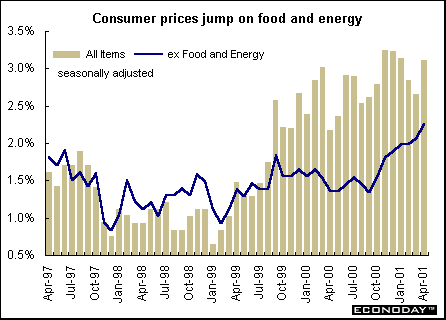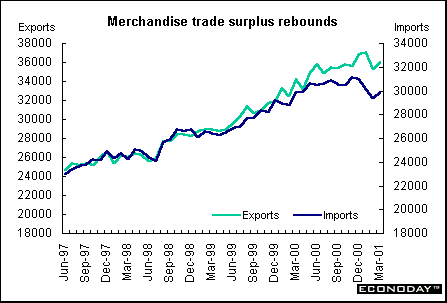
Indicator scoreboard
EMU- April harmonized index of consumer prices jumped 0.5 percent and 2.9 percent when compared with last year. The increase was caused mainly by rising food and energy prices. The core HICP, which excludes energy, food alcohol and tobacco rose a more sedate 0.3 percent in April and 1.9 percent when compared with last year. Core inflation remains below the ECB's inflation target of 2 percent.

Fourth quarter hourly wage costs rose 3.5 percent on the year, revised up from a 3.4 percent reading reported earlier. In the third quarter, the annual labor cost growth rate stood at 3.9 percent.
March industrial production declined 0.2 percent but rose 3.0 percent when compared with last year. First quarter industrial production slipped 0.1 percent when compared with fourth quarter 2000. March intermediate goods output declined 0.4 percent, non-durable consumer goods output fell 0.1 percent, but capital goods output and durable consumer goods output both increased 0.5 percent.

Germany - April wholesale prices rose 0.4 percent and 4.1 percent when compared with last year, fuelled by higher oil product prices. Excluding oil products, the WPI was flat on the month and up 3.2 percent when compared with last year. Energy prices jumped 2.3 percent on the month and 9.8 percent on the year because of the weak euro and higher fuel prices.
March manufacturing orders were revised upwardly to a decline of 3.0 percent from the original estimate of a drop of 4.4 percent. West German orders were revised to a decline of 2.6 percent from a drop of 4.2 percent, while east German orders were revised to a plunge of 6.3 percent from a drop of 6.5 percent. Foreign orders were revised up to a decline of 5.3 percent instead of the originally estimated decline of 7.0 percent; domestic orders were revised up to a drop 1.1 percent from an original drop of 2.3 percent.
March industrial production was revised up to a decline of 2.8 percent from a drop of 3.7 percent. Industrial production in west Germany declined 2.5 percent instead of the 3.4 percent drop originally reported. East Germany was revised to a drop of 4.8 percent from the decline of 5.7 percent originally reported.
France - March seasonally and workday adjusted manufacturing output fell 0.2 percent but rose 3.0 percent when compared with last year. Semi-finished and consumer goods production slumped. Industrial output was also down 0.2 percent but was up 1.9 percent on the year. Consumer goods output dropped 0.9 percent in March, and semi-finished goods output was down 0.7 percent
March seasonally adjusted merchandise trade surplus widened slightly to E940 million as imports declined faster than exports. Seasonally adjusted exports fell back 3.2 percent due to a further decline in semi-finished goods, electrical equipment, consumer goods and agricultural products. Imports fell 3.5 percent. Except autos, all sectors posted declines, especially semi-finished goods.
Italy - March seasonally and workday adjusted industrial production rose 0.5 percent and 3.2 percent when compared with last year. Seasonally adjusted consumer goods output rose 0.7 percent on the month and climbed an unadjusted 1.2 percent on the year.
First quarter preliminary real gross domestic product was up 0.7 percent and 2.3 percent when compared with last year. The increase was helped by the fact there were three more working days in the first quarter than in the fourth quarter. No data for components were released.
Britain - April seasonally adjusted producer input prices rose 1 percent and 6.7 percent when compared with last year. On an unadjusted basis, input prices rose 0.4 percent and were up 6.6 percent on the year. The latest jump in input prices was mostly attributable to crude oil. The price of crude oil rose by 6.3 percent on the month and by 22.2 percent on the year. Output prices continued to remain subdued. Output prices rose by 0.1 percent and 0.5 percent above levels of a year earlier. This was the lowest annual rate of increase since February 1999. Seasonally adjusted core output prices (excluding food, beverages, tobacco and petroleum) remained unchanged on the month but rose 0.3 percent on the year, the lowest annual rate since November 1999.
April retail price index (RPI) rose 0.5 percent and 1.8 percent when compared with last year. The retail price index excluding mortgage interest payments (RPIX) jumped 0.7 percent and 2.0 percent when compared with last year. Higher prices for gas and food offset declines in tobacco and clothing and footwear. RPIY, which excludes both mortgage interest payments and indirect taxes rose 0.5 percent in April, which pushed the annual rate up to 2.2 percent from 1.8 percent in March. The Bank of England regards RPIY as an important measure of underlying inflationary pressures. The RPIX remains comfortably below the Bank of England's 2.5 percent inflation target.

Average earnings rose 5.1 percent in the three months to March. Large bonuses paid by financial services firms continued to keep average earnings in March well above the Bank of England's 4.5 percent pain threshold. In March alone, the rate of earnings growth cooled to 4.4 percent from 6.5 percent in February and 4.3 percent in January.

April unemployment rate sank to 3.2 percent, the lowest since August 1975. Employment rose in the first quarter of the year by 100,000, compared with a rise of only 9,000 in the final quarter of last year. The International Labor Organization unemployment rate was 5.1 percent, down 0.2 percentage points from the previous three months and down 0.7 percentage points from a year earlier. The ILO definition excludes jobseekers that did any work during the month.

April seasonally adjusted retail sales volumes rose 0.6 percent and 5.9 percent when compared with last year. Growth in April was driven by a large rise in clothing and footwear sales, up 2.2 percent and 11.1 percent on the year. This was the highest annual rate of growth since records began in 1986.

Asia
Japan - March seasonally adjusted current account surplus was 731.8 billion yen, 44.8 percent lower than February, helped by a 43.9 percent drop in the trade surplus. March imports grew 9.8 percent to 3.57 trillion yen, or 11.5 percent to 4.0 trillion yen on a customs-declared basis. The growth in overall imports was due to a 27.9 percent rise in semiconductor imports and an 18.9 percent rise in clothing related products when compared with last year. March exports gained 3.1 percent on the year as exports of shipping vessels grew 34.5 percent and exports of office equipment increased 7.0 percent.
Bankruptcy claimed 1,575 companies in April. With banks getting tougher on loan defaults, failures are expected to stay high. The number of failed companies, up 0.8 percent from a year earlier, owed 977.7 billion yen ($7.9 billion), said credit research firm Tokyo Shoko Research Ltd. In the first four months of this year, 6,132 companies declared bankruptcy, in line with the 1,500, on average, that have declared bankruptcy in each month for the past four years. The increase in bankruptcies last month was led by the number of financial and insurance companies going out of business, which more than doubled from a year earlier. Real estate bankruptcies rose by 35 percent.
Americas
Canada - March manufacturers shipments rose 1.7 percent following February's 3.9 percent slide. Increases in the motor vehicle (up 5.3 percent) and computer and electronic products (up 5.9 percent) industries boosted shipments. Higher values were reported in 15 of 21 industries, accounting for 85 percent of total manufacturing shipments. March inventory levels were unchanged at C$65.3 billion, after gradual increases over the first two months of 2001. Coupled with the slight rebound in shipments, the inventories-to-shipments ratio recovered to 1.49, compared with February's jump to 1.52. Unfilled orders resumed a downward shift for the third time in four months, decreasing 1.6 percent. New orders also lost most of February's gain, declining 3.5 percent.
April unadjusted consumer prices were up 0.7 percent, more than double the 0.3 percent increase in March, largely due to increases in prices for energy, cigarettes and fresh fruit. When compared with a year earlier, the CPI was up 3.6 percent. The April increase is the largest observed since December 1991. Higher gasoline prices were the main cause. Energy prices rose 11.6 percent when compared with last year. The CPI excluding food and energy rose by 0.4 percent and 2.1 percent when compared with last year. The Bank of Canada has a control target of 1 percent to 3 percent for consumer price inflation. The Bank bases its policy actions on a core measure of the CPI excluding food, energy and the effects of indirect taxes. Seasonally adjusted CPI rose 0.26 percent and 3.1 percent when compared with last year.

March international merchandise trade surplus rose to C$6.16 billion, up from a C$5.84 billion surplus in February. Exports were up 2.3 percent, halting two consecutive months of declines. Merchandise exports rebounded because of a modest recovery in machinery and equipment, mainly high tech, and in agricultural and fishing products. Imports were up 1.7 percent on the strength of a rebound in the automotive sector. A slight decline in the trade surplus with the United States was offset by a slightly improved trade balance with other partners.



Introduction • Global Stock Market Indexes • Recap of Global Markets • Currencies • Indicator Scoreboard

The Bottom Line • Looking Ahead
|